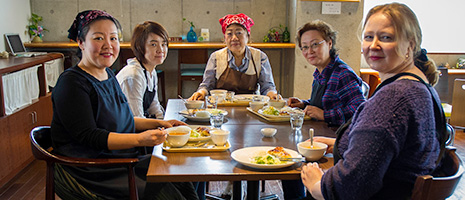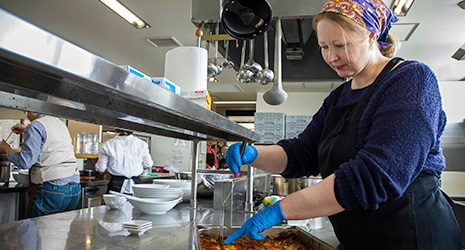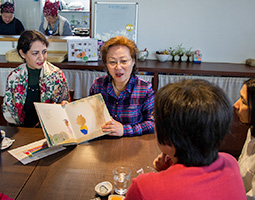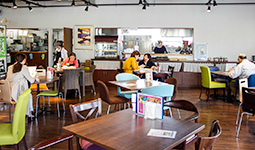Home > Highlighting JAPAN > Highlighting Japan June 2019 > Toward a Multicultural Symbiotic Society
Highlighting JAPAN


International Café a Popular Lunch Haunt
In April 2019, we visited a café in Minoh City, Osaka Prefecture, where each day a different foreign chef prepares cuisine from their native country for neighborhood residents. There, we observed foreign nationals residing in an unfamiliar land and local residents interacting cheerfully through dishes from around the world.
Minoh Multicultural Center is located in a quiet residential area in the north of Osaka Prefecture. The first floor of the center houses the Minoh City Onohara Library, as well as “comm cafe,” which started operating when the Center first opened. Every lunchtime from Tuesday to Saturday, twenty-four foreign residents from fourteen countries take it in turns to be chef for the day, preparing home-cooked meals from around the world.
Most of the café’s patrons are residents of the neighborhood. Although there had been demand for a library in this district for many years, some expressed concern over the establishment of the new Multicultural Center, which is managed by the Minoh Association For Global Awareness. However, since its opening, the café has attracted over 30,000 people each year.
Today’s chef is Natalia Mikhaylenko from Russia. The main menu is “The Captain’s Meat,” which is made by layering pork, potatoes and onions, and baking slowly in the oven.
“In the old days, meat was a luxury food only available to people of high social status, so it was called ‘Captain’s.’ Now, though, it’s a common household dish in my hometown of Vladivostok,” explains Natalia.
Asuka Iwaki is Director of Minoh Multicultural Center and occasionally helps out in the café kitchen. “At comm cafe you can enjoy dishes from different countries as though you were traveling around the world. But we don’t display flags or do anything to emphasize the country of origin of the chef. We want customers to see the chefs as individuals,” she says. The café is designed to let sunlight stream in, creating a bright, welcoming atmosphere, while the layout gives diners a good view of the chef preparing the food on the other side of the counter.
With a population of approximately 135,000, Minoh City is home to some 2,800 foreign nationals hailing from 100 countries. Korean Choi Seong-ja has been a multilingual counselor in the area for many years, and has listened to many foreign women’s troubles during that time. “Women who marry Japanese or migrate to Japan because of their spouse’s job tend to be isolated from the community. It’s hard for them being in unfamiliar surroundings and not understanding much of the language, and they feel lonely,” says Choi.
For women such as these, Choi came up with the idea of preparing food from their native country and serving it to the local people, enabling them to be themselves while having a point of contact with the community. The venture trialed in 2010, after which community cafés came to be held at irregular intervals several times a year. Then in 2013, after the establishment of the Multicultural Center, she suggested that the café become a permanent feature, and comm cafe was born.
The café operates on a “chef-of-the-day” system. Supported by staff from the Minoh Association For Global Awareness, which operates the café, as well as some twenty volunteers, working in shifts, the chef of the day takes care of everything from menu planning to the purchase of materials and preparation of meals. The chef pays 30% of sales to the Association, and the Association pays a portion of the labor costs.
According to Iwaki and Choi, running a café is tough if you think about profitability, but those who may have lost sight of their own value in an unfamiliar land regain their self-esteem and their lives take on a new vitality. comm cafe has that power.
As a place where people of different cultural backgrounds come together, it is not possible to impose the same methods of customer service on the foreign service staff at comm cafe as patrons would experience at Japanese restaurants. For example, in a Japanese establishment, the staff notice when a customer’s water glass is empty and come and refill it. However, this level of customer service may be regarded as excessive by foreigners on the staff and make them feel uncomfortable. They may think, if the customer needs something, they will ask for it. Even if there is friction at times, by engaging in dialogue not only with workers but also with customers in order to find the best way to achieve the “comm cafe flow” unique to a multicultural environment, the know-how to achieve a harmonious atmosphere between service staff and customers has slowly been accumulated.
As well as serving food, the café hosts various events such as workshops where customers can experience world cultures, and live folk music. Six years after it opened, comm cafe has grown into a place where people who have left their home countries and local people can interact with each other regardless of generation or nationality.
© 2009 Cabinet Office, Government of Japan








